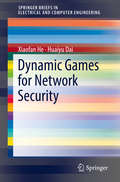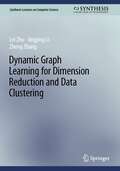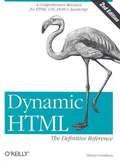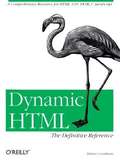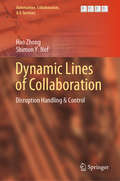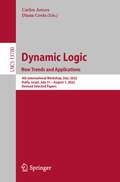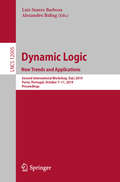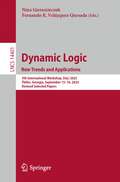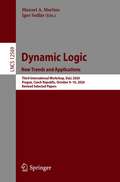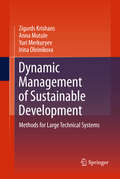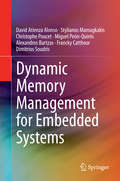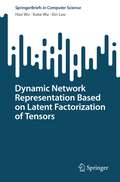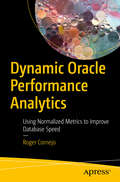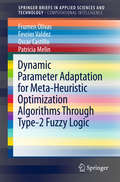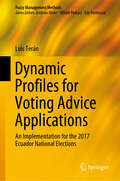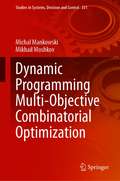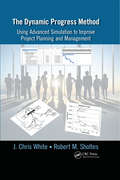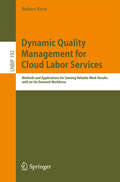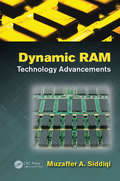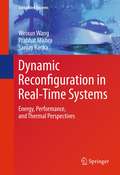- Table View
- List View
Dynamic Formal Epistemology
by Olivier Roy Patrick Girard Mathieu MarionThis volume is a collation of original contributions from the key actors of a new trend in the contemporary theory of knowledge and belief, that we call "dynamic epistemology". It brings the works of these researchers under a single umbrella by highlighting the coherence of their current themes, and by establishing connections between topics that, up until now, have been investigated independently. It also illustrates how the new analytical toolbox unveils questions about the theory of knowledge, belief, preference, action, and rationality, in a number of central axes in dynamic epistemology: temporal, social, probabilistic and even deontic dynamics.
Dynamic Games for Network Security (Springerbriefs In Electrical And Computer Engineering)
by Xiaofan He Huaiyu DaiThe goal of this SpringerBrief is to collect and systematically present the state-of-the-art in this research field and the underlying game-theoretic and learning tools to the broader audience with general network security and engineering backgrounds. Particularly, the exposition of this book begins with a brief introduction of relevant background knowledge in Chapter 1, followed by a review of existing applications of SG in addressing various dynamic network security problems in Chapter 2. A detailed treatment of dynamic security games with information asymmetry is given in Chapters 3–5. Specifically, dynamic security games with extra information that concerns security competitions, where the defender has an informational advantage over the adversary are discussed in Chapter 3. The complementary scenarios where the defender lacks information about the adversary is examined in Chapter 4 through the lens of incomplete information SG. Chapter 5 is devoted to the exploration of how to proactively create information asymmetry for the defender’s benefit.The primary audience for this brief includes network engineers interested in security decision-making in dynamic network security problems. Researchers interested in the state-of-the-art research on stochastic game theory and its applications in network security will be interested in this SpringerBrief as well. Also graduate and undergraduate students interested in obtaining comprehensive information on stochastic game theory and applying it to address relevant research problems can use this SpringerBrief as a study guide. Lastly, concluding remarks and our perspective for future works are presented in Chapter 6.
Dynamic Graph Learning for Dimension Reduction and Data Clustering (Synthesis Lectures on Computer Science)
by Lei Zhu Jingjing Li Zheng ZhangThis book illustrates how to achieve effective dimension reduction and data clustering. The authors explain how to accomplish this by utilizing the advanced dynamic graph learning technique in the era of big data. The book begins by providing background on dynamic graph learning. The authors discuss why it has attracted considerable research attention in recent years and has become well recognized as an advanced technique. After covering the key topics related to dynamic graph learning, the book discusses the recent advancements in the area. The authors then explain how these techniques can be practically applied for several purposes, including feature selection, feature projection, and data clustering.
Dynamic HTML: The Definitive Reference, 2nd Edition
by Danny GoodmanDynamic HTML: The Definitive Reference, 2nd Edition, is an indispensable compendium for web development. The new edition has been updated to include complete reference material on the latest specifications, including HTML 4.01, CSS Level 2, DOM Level 2, and JavaScript 1.5, as well as the latest browsers, Internet Explorer 6 (Windows), Internet Explorer 5.1 (Mac), Netscape Navigator 6 and 7, and Mozilla 1.0.
Dynamic HTML: The Definitive Reference
by Danny GoodmanIf you are a Web content developer these days, you have a lot of information to keep track of. You need to stay current on the relevant Web specifications, like HTML, CSS, DOM, and ECMAScript. You also need to know how the latest Web browsers from Netscape and Microsoft actually implement these standards, since browser implementations of the standards are less than perfect. Right now, you're forced to keep multiple reference books open on your desk (or multiple browser windows open on your screen), just to develop a simple dynamic Web page that works properly under both Navigator and Internet Explorer. Dynamic HTML: The Definitive Reference changes all that. This book is an indispensable compendium for Web content developers. It contains everything you need to create functional cross-platform Web applications, including: A complete reference for all of the HTML tags, CSS style attributes, browser document objects, and JavaScript objects supported by the various standards and the latest versions of Navigator and Internet Explorer. Browser compatibility is emphasized throughout; the reference pages clearly indicate browser support for every entity. Handy cross-reference indexes that make it easy to find interrelated HTML tags, style attributes, and document objects. An advanced introduction to creating dynamic Web content that addresses the cross-platform compromises inherent in Web page design today. If you have some experience with basic Web page creation, but are new to the world of dynamic content, Dynamic HTML: The Definitive Reference will jump-start your development efforts. If you are an experienced Web programmer, you'll find the browser-compatibility information invaluable. This book is the only DHTML reference that a Web developer needs. Dynamic HTML: The Definitive Reference is designed to work in conjunction with HTML: The Definitive Guide and JavaScript: The Definitive Guide . HTML: The Definitive Guide teaches you about every element of HTML in detail, with explanations of how each element works and how it interacts with other elements, as well as numerous examples. JavaScript: The Definitive Guide provides a thorough description of the JavaScript language, complete with sophisticated examples that show you how to handle common Web application tasks. Together, these three books provide a complete library for Web content developers.
Dynamic Lines of Collaboration: Disruption Handling & Control (Automation, Collaboration, & E-Services #6)
by Hao Zhong Shimon Y. NofThis book focuses on the systematic modeling of complex situations characterized by escalating disruptions, and on cycles of dynamic collaboration for the best handling of disruptions. What can we do about disruptive events and their cascading effects? Thanks to the evolution of intelligent technologies for interaction, communication, sharing, and collaboration, cyberspace is a rapidly expanding world. Our systems of machines, software services, and human organizations have become increasingly interdependent, in other words – networked. As a result, disruptions that initially affect only a small part of any network tend to escalate. At the same time, cyber solutions can support first responders and emergency handlers, enhancing their responsiveness and ability to collaborate with one another in controlling disruptions and preventing their escalation. In this book, we are chiefly interested in how effectively these collaborations can be supported and how we can further optimize such support. Solution guidelines for optimizing collaborations are illustrated with examples in various application domains: agricultural robotics, civil cyber-physical infrastructure, visual analytics, manufacturing automation, and supply chains. Open-source simulation tools are also provided to supplement the main content.
Dynamic Logic. New Trends and Applications: 4th International Workshop, DaLí 2022, Haifa, Israel, July 31–August 1, 2022, Revised Selected Papers (Lecture Notes in Computer Science #13780)
by Carlos Areces Diana CostaThis book constitutes revised selected papers from the refereed proceedings of the 4th International Workshop on Dynamic Logic, DaLí 2022, held in Haifa, Israel, in July/August 2022.The 8 full papers presented in this volume were carefully reviewed and selected from 22 submissions. They deal with new trends and applications in the area of Dynamic Logic.
Dynamic Logic. New Trends and Applications: Second International Workshop, DaLí 2019, Porto, Portugal, October 7–11, 2019, Proceedings (Lecture Notes in Computer Science #12005)
by Alexandru Baltag Luís Soares BarbosaThis book constitutes the proceedings of the Second International Workshop on Dynamic Logic, DALI 2019, held in Porto, Portugal in October 2019. The workshop was held in Porto, Portugal, on October 9, 2019, as part of the Formal Methods Week which hosted the 3rd World Congress on Formal Methods. The 12 full papers presented together with 2 short papers were carefully reviewed and selected from 26 submissions. The workshop is based on the project DaLí – Dynamic logics for cyber-physical systems: towards contract based design.
Dynamic Logic. New Trends and Applications: 5th International Workshop, DaLí 2023, Tbilisi, Georgia, September 15–16, 2023, Revised Selected Papers (Lecture Notes in Computer Science #14401)
by Nina Gierasimczuk Fernando R. Velázquez-QuesadaThis book constitutes the revised selected papers of the 5th International Workshop on Dynamic Logic. New Trends and Applications, DaLí 2023, held in Tbilisi, Georgia, during September 15–16, 2023. The 8 full papers in this book were carefully reviewed and selected from 10 submissions. They deal with new trends and applications in the area of Dynamic Logic.
Dynamic Logic. New Trends and Applications: Third International Workshop, DaLí 2020, Prague, Czech Republic, October 9–10, 2020, Revised Selected Papers (Lecture Notes in Computer Science #12569)
by Manuel A. Martins Igor SedlárThis book constitutes the proceedings of the Third International Workshop on Dynamic Logic, DaLí 2019, held in Prague, Czech Republic in October 2020. Due to COVID-19 the workshop has been held online. The 17 full papers presented together with 6 short papers were carefully reviewed and selected from 31 submissions. The theoretical relevance and practical potential of dynamic logic is a topic of interest in a number of scientific venues, from wide-scope software engineering conferences to modal logic specific events. The DaLí 2020 workshop is exclusively dedicated to Dynamic logic and aims at filling this gap and creating a heterogeneous community of colleagues, from Academia to Industry, from Mathematics to Computer Science.
Dynamic Management of Sustainable Development
by Irina Oleinikova Anna Mutule Yuri Merkuryev Zigurds KrishansDynamic management of systems development is a precondition for the realization of sustainable system development. This approach allows for the usage of systems theory methods that take into consideration the interaction of decisions made over time and space. A characteristic feature of this kind of method is that the process of sophisticated object development over time is examined for optimal decision selection. This requires the application of modelling methods that represent properties of the developing objects, high speed calculation methods for the estimation of technical and economic characteristics, as well as effective optimization methods. Dynamic Management of Sustainable Development presents a concise summary of the authors' research in the area of dynamic methods analysis of technical systems development. Along with systematic illustration of mathematical methods, considerable attention is drawn to practical realization and applications. Dynamic Management of Sustainable Development will be helpful for scientists involved in the mathematical modelling of large technical systems development and for engineers working in the area of large technical systems planning.
Dynamic Memory Management for Embedded Systems
by David Atienza Alonso Stylianos Mamagkakis Christophe Poucet Miguel Peón-Quirós Alexandros Bartzas Francky Catthoor Dimitrios SoudrisThis book provides a systematic and unified methodology, including basic principles and reusable processes, for dynamic memory management (DMM) in embedded systems. The authors describe in detail how to design and optimize the use of dynamic memory in modern, multimedia and network applications, targeting the latest generation of portable embedded systems, such as smartphones. Coverage includes a variety of design and optimization topics in electronic design automation of DMM, from high-level software optimization to microarchitecture-level hardware support. The authors describe the design of multi-layer dynamic data structures for the final memory hierarchy layers of the target portable embedded systems and how to create a low-fragmentation, cost-efficient, dynamic memory management subsystem out of configurable components for the particular memory allocation and de-allocation patterns for each type of application. The design methodology described in this book is based on propagating constraints among design decisions from multiple abstraction levels (both hardware and software) and customizing DMM according to application-specific data access and storage behaviors.
Dynamic Models in Biology
by Stephen P. Ellner John GuckenheimerFrom controlling disease outbreaks to predicting heart attacks, dynamic models are increasingly crucial for understanding biological processes. Many universities are starting undergraduate programs in computational biology to introduce students to this rapidly growing field. In Dynamic Models in Biology, the first text on dynamic models specifically written for undergraduate students in the biological sciences, ecologist Stephen Ellner and mathematician John Guckenheimer teach students how to understand, build, and use dynamic models in biology. Developed from a course taught by Ellner and Guckenheimer at Cornell University, the book is organized around biological applications, with mathematics and computing developed through case studies at the molecular, cellular, and population levels. The authors cover both simple analytic models--the sort usually found in mathematical biology texts--and the complex computational models now used by both biologists and mathematicians. Linked to a Web site with computer-lab materials and exercises, Dynamic Models in Biology is a major new introduction to dynamic models for students in the biological sciences, mathematics, and engineering.
Dynamic Models of Infectious Diseases
by V. Sree Hari Rao Ravi DurvasulaThough great advances in public health are witnessed world over in recent years, infectious diseases, besides insect vector-borne infectious diseases remain a leading cause of morbidity and mortality. Control of the epidemics caused by the non-vector borne diseases such as tuberculosis, avian influenza (H5N1) and cryptococcus gattii, have left a very little hope in the past. The advancement of research in science and technology has paved way for the development of new tools and methodologies to fight against these diseases. In particular, intelligent technology and machine-learning based methodologies have rendered useful in developing more accurate predictive tools for the early diagnosis of these diseases. In all these endeavors the main focus is the understanding that the process of transmission of an infectious disease is nonlinear (not necessarily linear) and dynamical in character. This concept compels the appropriate quantification of the vital parameters that govern these dynamics. This book is ideal for a general science and engineering audience requiring an in-depth exposure to current issues, ideas, methods, and models. The topics discussed serve as a useful reference to clinical experts, health scientists, public health administrators, medical practioners, and senior undergraduate and graduate students in applied mathematics, biology, bioinformatics, and epidemiology, medicine and health sciences.
Dynamic Network Representation Based on Latent Factorization of Tensors (SpringerBriefs in Computer Science)
by Hao Wu Xuke Wu Xin LuoA dynamic network is frequently encountered in various real industrial applications, such as the Internet of Things. It is composed of numerous nodes and large-scale dynamic real-time interactions among them, where each node indicates a specified entity, each directed link indicates a real-time interaction, and the strength of an interaction can be quantified as the weight of a link. As the involved nodes increase drastically, it becomes impossible to observe their full interactions at each time slot, making a resultant dynamic network High Dimensional and Incomplete (HDI). An HDI dynamic network with directed and weighted links, despite its HDI nature, contains rich knowledge regarding involved nodes’ various behavior patterns. Therefore, it is essential to study how to build efficient and effective representation learning models for acquiring useful knowledge. In this book, we first model a dynamic network into an HDI tensor and present the basic latent factorization of tensors (LFT) model. Then, we propose four representative LFT-based network representation methods. The first method integrates the short-time bias, long-time bias and preprocessing bias to precisely represent the volatility of network data. The second method utilizes a proportion-al-integral-derivative controller to construct an adjusted instance error to achieve a higher convergence rate. The third method considers the non-negativity of fluctuating network data by constraining latent features to be non-negative and incorporating the extended linear bias. The fourth method adopts an alternating direction method of multipliers framework to build a learning model for implementing representation to dynamic networks with high preciseness and efficiency.
Dynamic Oracle Performance Analytics: Using Normalized Metrics to Improve Database Speed
by Roger CornejoUse an innovative approach that relies on big data and advanced analytical techniques to analyze and improve Oracle Database performance. The approach used in this book represents a step-change paradigm shift away from traditional methods. Instead of relying on a few hand-picked, favorite metrics, or wading through multiple specialized tables of information such as those found in an automatic workload repository (AWR) report, you will draw on all available data, applying big data methods and analytical techniques to help the performance tuner draw impactful, focused performance improvement conclusions. This book briefly reviews past and present practices, along with available tools, to help you recognize areas where improvements can be made. The book then guides you through a step-by-step method that can be used to take advantage of all available metrics to identify problem areas and work toward improving them. The method presented simplifies the tuning process and solves the problem of metric overload.You will learn how to: collect and normalize data, generate deltas that are useful in performing statistical analysis, create and use a taxonomy to enhance your understanding of problem performance areas in your database and its applications, and create a root cause analysis report that enables understanding of a specific performance problem and its likely solutions. What You'll LearnCollect and prepare metrics for analysis from a wide array of sourcesApply statistical techniques to select relevant metrics Create a taxonomy to provide additional insight into problem areasProvide a metrics-based root cause analysis regarding the performance issueGenerate an actionable tuning plan prioritized according to problem areasMonitor performance using database-specific normal rangesWho This Book Is ForProfessional tuners: responsible for maintaining the efficient operation of large-scale databases who wish to focus on analysis, who want to expand their repertoire to include a big data methodology and use metrics without being overwhelmed, who desire to provide accurate root cause analysis and avoid the cyclical fix-test cycles that are inevitable when speculation is used
Dynamic Parameter Adaptation for Meta-Heuristic Optimization Algorithms Through Type-2 Fuzzy Logic (SpringerBriefs in Applied Sciences and Technology)
by Frumen Olivas Fevrier Valdez Oscar Castillo Patricia MelinIn this book, a methodology for parameter adaptation in meta-heuristic op-timization methods is proposed. This methodology is based on using met-rics about the population of the meta-heuristic methods, to decide through a fuzzy inference system the best parameter values that were carefully se-lected to be adjusted. With this modification of parameters we want to find a better model of the behavior of the optimization method, because with the modification of parameters, these will affect directly the way in which the global or local search are performed.Three different optimization methods were used to verify the improve-ment of the proposed methodology. In this case the optimization methods are: PSO (Particle Swarm Optimization), ACO (Ant Colony Optimization) and GSA (Gravitational Search Algorithm), where some parameters are se-lected to be dynamically adjusted, and these parameters have the most im-pact in the behavior of each optimization method.Simulation results show that the proposed methodology helps to each optimization method in obtaining better results than the results obtained by the original method without parameter adjustment.
Dynamic Posing Guide
by Jeanne Harris Craig StidhamTips, techniques, and inspiration for creating perfect posesEffectively posing the human body is a challenge for nearly every photographer, from amateur to professional. Understanding how a model's pose, body language, and posture affect a photograph is crucial to success. Author and professional fashion photographer Craig Stidham shows you how to guide a subject's personality through body language, with hundreds of examples and suggestions. Answers critical questions such as: how can a photographer avoid having the subject look awkward? How does one direct both experienced and inexperienced models?Shares helpful posing tips and techniques for posing models in new modern and fashion-forward waysSuggests ways to make strategic edits in post-production to fix common posing mistakes Offers hundreds of examples of strong and stunning posingDynamic Posing Guide teaches you the skills you need to identify strong modern posing techniques as you strengthen your photographic skills.
Dynamic Power Supply Transmitters: Envelope Tracking, Direct Polar, and Hybrid Combinations (The Cambridge RF and Microwave Engineering Series)
by Earl MccuneLearn how envelope tracking, polar modulation, and hybrid designs using these techniques, really work. The first physically based and coherent book to bring together a complete overview of such circuit techniques, this is an invaluable resource for practising engineers, researchers and graduate students working on RF power amplifiers and transmitters. Learn how to create more successful designs. • Step-by-step design guidelines and real world case studies show you how to put these techniques into practice • A survey of how various transistor technologies help you to choose which transistor type to use for best results • Detail on the test and measurement of all aspects of these designs explains how to measure what the circuit is actually doing and how to interpret measurement results. The first book to provide a physically consistent overview of dynamic power supply technologies and circuit techniques for increased transmitter energy efficiency. Covers the basic physical theory as well as providing case studies, step-by-step design guidelines, and practical advice for practitioners. Includes a survey of current transistor technologies and details on the testing and calibration of all aspects of such designs.
Dynamic Profiles for Voting Advice Applications: An Implementation for the 2017 Ecuador National Elections (Fuzzy Management Methods)
by Luis TeránElectronic participation is an emerging and growing research area that makes use of internet solutions to enhance citizens' participation in government processes in order to provide a fair and efficient society. This book examines recommender-system technologies and voting advice applications as tools to enable electronic citizen participation during election campaigns. Further, making use of fuzzy classification, it provides an evaluation framework for eParticipation. A dynamic voting advice application developed for the 2017 Ecuador national election serves as a real-world case study to introduce readers to the practical implementation and evaluation issues. The book concludes with a comprehensive analysis of the 2017 election project based on altmetrics, Google Analytics and statistics from the case study.
Dynamic Programming Multi-Objective Combinatorial Optimization (Studies in Systems, Decision and Control #331)
by Michal Mankowski Mikhail MoshkovThis book introduces a fairly universal approach to the design and analysis of exact optimization algorithms for multi-objective combinatorial optimization problems. It proposes the circuits without repetitions representing the sets of feasible solutions along with the increasing and strictly increasing cost functions as a model for such problems. The book designs the algorithms for multi-stage and bi-criteria optimization and for counting the solutions in the framework of this model.As applications, this book studies eleven known combinatorial optimization problems: matrix chain multiplication, global sequence alignment, optimal paths in directed graphs, binary search trees, convex polygon triangulation, line breaking (text justification), one-dimensional clustering, optimal bitonic tour, segmented least squares, optimization of matchings in trees, and 0/1 knapsack problem.The results presented are useful for researchers in combinatorial optimization. This book is also useful as the basis for graduate courses.
The Dynamic Progress Method: Using Advanced Simulation to Improve Project Planning and Management
by J. Chris White Robert M. SholtesRecent computer-based tools for project planning and management focus on user-friendliness and interconnectivity. However, these programs function on the Critical Path Method, or CPM, which was created in the 1950s. These programs, which involve simplistic models and methods, ignore the fact that the underlying computations on which they function h
Dynamic Quality Management for Cloud Labor Services
by Robert KernHow can a scalable and efficient quality management mechanism for cloud labor services be designed in a way that it delivers results with a well-defined level of quality to the requester? Cloud labor services are a specific form of crowdsourcing: A coordination platform serves as an interface between requesters who need to get work done and a large crowd of workers who want to perform work. An early example of such a platform is Amazon's Web marketplace Mturk, on which service requesters can publish open calls for so-called human intelligence tasks (HITs). Robert Kern's work makes a considerable contribution toward solving the quality problem for scalable human work. On the basis of a comprehensive framework of cloud labor, he develops a set of methods to conceptually measure and aggregate the quality of human work results, implements a platform to put those methods to work, and evaluates their application in a number of very compelling, real-world scenarios successfully combining concepts from statistics, information technology, and management. Reading this book will be beneficial to novices in cloud labor services looking for orientation in this new field as well as to advanced researchers and practitioners developing cloud quality concepts.
Dynamic RAM: Technology Advancements
by Muzaffer A. SiddiqiBecause of their widespread use in mainframes, PCs, and mobile audio and video devices, DRAMs are being manufactured in ever increasing volume, both in stand-alone and in embedded form as part of a system on chip. Due to the optimum design of their components—access transistor, storage capacitor, and peripherals—DRAMs are the cheapest and densest semiconductor memory currently available. As a result, most of DRAM structure research and development focuses on the technology used for its constituent components and their interconnections. However, only a few books are available on semiconductor memories in general and fewer on DRAMs. Dynamic RAM: Technology Advancements provides a holistic view of the DRAM technology with a systematic description of the advancements in the field since the 1970s, and an analysis of future challenges. Topics Include: DRAM cells of all types, including planar, three-dimensional (3-D) trench or stacked, COB or CUB, vertical, and mechanically robust cells using advanced transistors and storage capacitors Advancements in transistor technology for the RCAT, SCAT, FinFET, BT FinFET, Saddle and advanced recess type, and storage capacitor realizations How sub 100 nm trench DRAM technologies and sub 50 nm stacked DRAM technologies and related topics may lead to new research Various types of leakages and power consumption reduction methods in active and sleep mode Various types of SAs and yield enhancement techniques employing ECC and redundancy A worthwhile addition to semiconductor memory research, academicians and researchers interested in the design and optimization of high-density and cost-efficient DRAMs may also find it useful as part of a graduate-level course.
Dynamic Reconfiguration in Real-Time Systems
by Prabhat Mishra Weixun Wang Sanjay RankaGiven the widespread use of real-time multitasking systems, there are tremendous optimization opportunities if reconfigurable computing can be effectively incorporated while maintaining performance and other design constraints of typical applications. The focus of this book is to describe the dynamic reconfiguration techniques that can be safely used in real-time systems. This book provides comprehensive approaches by considering synergistic effects of computation, communication as well as storage together to significantly improve overall performance, power, energy and temperature.

